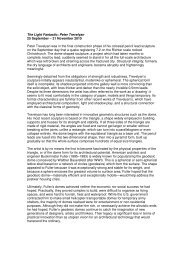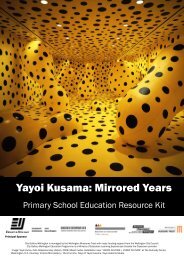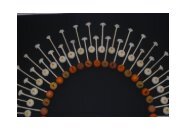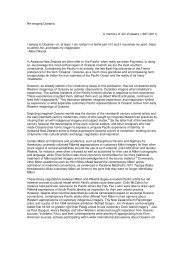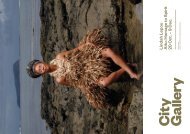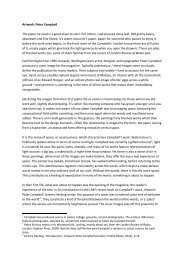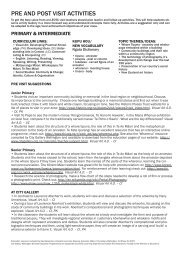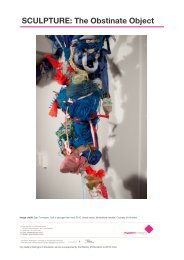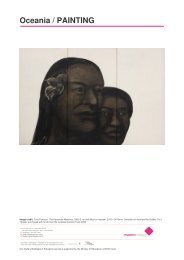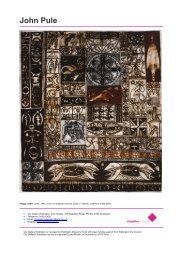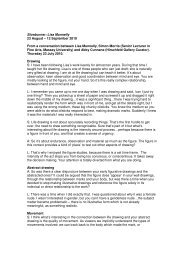Curator's essay - City Gallery Wellington
Curator's essay - City Gallery Wellington
Curator's essay - City Gallery Wellington
You also want an ePaper? Increase the reach of your titles
YUMPU automatically turns print PDFs into web optimized ePapers that Google loves.
Campbell Kneale:<br />
201012.<br />
20 Oct. – 9 Dec.<br />
Campbell Kneale<br />
Our Love Will Destroy the World<br />
Photo: Bryan Spencer, 2011<br />
Courtesy of the artist
Hirschfeld <strong>Gallery</strong><br />
20 Oct. – 9 Dec. 2012<br />
<strong>City</strong> <strong>Gallery</strong> <strong>Wellington</strong><br />
Te Whare Toi<br />
Open Daily 10am–5pm<br />
Free Entry<br />
The Hirschfeld <strong>Gallery</strong> is<br />
dedicated to exhibiting work<br />
by <strong>Wellington</strong>-based artists<br />
and designers.<br />
LH: I recently read a quote that reminded me of your<br />
work: ‘it is in the opposite of capture and containment,<br />
namely discharge and leakage, that we discover the life<br />
of things.’ I feel like this quite accurately reflects your<br />
own approach to making – as a compulsion and as<br />
CK: Here’s something to run by you by way of an evolving<br />
concept … Firstly, I think the viewer should make the<br />
links between the sound aspect and the visual aspect.<br />
Although the idea that the music is somehow linked to<br />
painting has always formed a question in my mind, I’ve<br />
never actually attempted to link the two. People seem<br />
to see a link and that’s nice. Being on the ‘inside’ of both<br />
these practices, I don’t see that link so easily. Funny,<br />
perhaps we let people find what they will.<br />
The text that follows is dedicated to the gradual<br />
evolution of this work, traced through excerpts from<br />
on-going email conversations between Campbell Kneale<br />
and curator Lily Hacking.<br />
Usually operating within their own distinct terms of<br />
reference, this exhibition is to some extent an invitation<br />
to encounter Kneale’s unique visual and sound practices<br />
in a way that is not usually possible outside his own<br />
reclusive work environment. Consequently, 201012 is<br />
less about a finite outcome and more about an artist<br />
grappling with his own creative processes in a particular<br />
time and place. This exhibition is full of the possibility<br />
for encounter and transformation; the work equally<br />
extending the prospect of obliteration or revelation;<br />
despair or elation.<br />
This exhibition focuses on one artist’s dynamic<br />
approach to making, with Campbell Kneale bringing<br />
together his painting and sound practices for the<br />
first time in a gallery context.<br />
Campbell<br />
Kneale:<br />
201012<br />
Campbell Kneale<br />
Destroyed Painting 001 (Giza), 2012<br />
oil and acrylic on canvas<br />
915mm x 1220mm<br />
Courtesy of the artist<br />
something that is constantly changing as you yourself<br />
are changing.<br />
CK: Wow … That’s beautiful. I love it. Yeah. I think the<br />
evolution of the work has more to do with the increasing<br />
richness that is found inside the work itself rather than<br />
any conscious attempt to grapple with ideas in the work<br />
from the outside. I don’t really grapple with ideas in<br />
painting or music … I grapple with them in real life. My art<br />
practices are not about ideas – they are an affirmation<br />
of my continued existence and my (inexplicable) desire<br />
to make.<br />
To be honest I don’t know why I make the work other<br />
than pure, unadulterated, compulsion. Perhaps this is the<br />
same reason anybody ever made art? The connections<br />
I make to various themes are usually fleeting, adding to<br />
a raft of ideas and fascinations that I hold that wax and<br />
wane with time. You can probably see from our on-going<br />
email conversations that the meanings and themes<br />
in the work are very fluid and constantly revealing<br />
themselves in real time.<br />
LH: What about the title of the show? We’ve talked about<br />
a few options but the last one simply made reference to<br />
the date of the opening.<br />
CK: Over time I have found the work capable of<br />
containing a pretty diverse range of fascinations and<br />
experiences … forest fires, heavy metal, economic<br />
and environmental collapse, cosmological emptiness,<br />
silence, noise, suburban decay, religious epiphany, high<br />
school teaching … the work has always been about<br />
these things, it’s just that it has taken key moments<br />
or experiences to realise it. But the time and place is<br />
perhaps the true nature of the work. So just like the<br />
paintings are titled with a date and time of their making,<br />
it seems entirely appropriate that this show should be<br />
titled with the opening date.<br />
Bond Street<br />
Central<br />
Library<br />
Harris Street<br />
<strong>City</strong><br />
<strong>Gallery</strong><br />
Civic Square<br />
P<br />
<strong>Wellington</strong> Festival<br />
& Convention Centre<br />
Wakefield Street<br />
Town<br />
Hall<br />
<strong>City</strong> to Sea Bridge<br />
Capital E<br />
Michael<br />
Fowler<br />
Centre<br />
Lagoon<br />
P<br />
Campbell Kneale:<br />
201012<br />
Artist talk<br />
27 Oct. 2pm<br />
Hirschfeld <strong>Gallery</strong>,<br />
<strong>City</strong> <strong>Gallery</strong><br />
Free entry<br />
Campbell Kneale<br />
Destroyed Painting 004 (Taita), 2012<br />
oil and acrylic on canvas<br />
915mm x 1220mm<br />
Courtesy of the artist<br />
CK: Anything that resembles a sculptural approach<br />
toward the sound (like amps, speakers, electronic music<br />
gear etc) is only going to give people an excuse to turn<br />
their backs on the painting. There should be nothing<br />
of interest to look at – that part of it is not a ‘looking’<br />
experience. I feel that the sound component needs to<br />
‘match’ the painting’s level of intensity, projecting out<br />
into the room as far as it needs to go in order to create<br />
a similar of level of energy and meet the viewer of the<br />
LH: How will the sound component be presented in<br />
the space? I know that in your exhibition HUMDRUM<br />
at Enjoy Public Art <strong>Gallery</strong> (2005) you had speakers<br />
stacked in the gallery but how do you imagine the sound<br />
will function here? I suppose it depends on the extent<br />
to which you want the sound to function as a physical/<br />
visual component of the work?<br />
CK: Well, being ‘present’ is important to me. It’s almost<br />
code language for being fully alive and fully aware. The<br />
performance will be real and finite and if you see it you<br />
hopefully get ‘more’ from the whole exhibition or at<br />
least have an angle on things that not everybody gets.<br />
What I thought would be nice would be to start the<br />
sound component in the gallery just before the<br />
live performance ends so that when I’m done, the prerecorded<br />
soundtrack to the show will emerge out of<br />
the debris …<br />
LH: And how are you feeling about potentially integrating<br />
a live component into the work? This definitely seems<br />
like it will lend itself to this idea of temporality … but the<br />
performance will also kind of hover over the work, at<br />
least for those who saw or were even just aware of it<br />
taking place.<br />
Cover image<br />
Campbell Kneale<br />
201012, 2012<br />
oil and acrylic<br />
dimensions variable<br />
Courtesy the artist<br />
P<br />
Cuba Street<br />
Open Daily 10am–5pm<br />
Free Entry<br />
www.citygallery.org.nz<br />
Civic Square, PO Box 2199. <strong>Wellington</strong>, NZ.<br />
Phone: 64 4 801 3021<br />
Email: citygallery@wmt.org.nz<br />
Join the conversations on our Facebook<br />
page and on Twitter @<strong>City</strong><strong>Gallery</strong>Wgtn.<br />
Some of the works on display at <strong>City</strong><br />
<strong>Gallery</strong> <strong>Wellington</strong> may contain elements<br />
that may be challenging for younger<br />
viewers. Parental guidance is advised.<br />
P<br />
1. Tim Ingold, Bringing things to life: Creative entanglements in a<br />
world of materials (working paper #15), Manchester: University of<br />
Manchester , 2010, p.8 http://www.socialsciences.manchester.ac.uk<br />
Lily Hacking<br />
Hirschfeld <strong>Gallery</strong> Curator<br />
CK: I live in Featherston without television, radio, and<br />
if I want to read the newspaper I have to go and buy<br />
a coffee from the cafe at the end of the street. I am<br />
deeply suspect of the internet and its unquestioned<br />
and indispensable status in contemporary society.<br />
‘New media’ has proved profoundly disappointing to<br />
me. I hate most ‘proper’ bands … my performances have<br />
been euphemistically described as being “thoroughly<br />
unnerving in their generosity” which I think is wonderful.<br />
Nothing is held back, regardless of how many (or few)<br />
people are in attendance. In this sense what I do has<br />
never sought to be ‘audience-centric’ but is more like a<br />
snapshot of myself at a particular stage of a lifetime’s<br />
work. With this in mind, I feel like the show should be<br />
focused around the ‘simplest possible gesture,’ like my<br />
work has always been.<br />
LH: The corner location sits well with me – I imagine<br />
it will draw out more of that slight sense of wary<br />
antagonism between these practices. Initially the two<br />
continuously looping tracks will almost be engaged in<br />
a kind of conversation, but as they gradually become<br />
more and more out of sync the lines of communication/<br />
cohesion will start to disintegrate and what emerges will<br />
be something else entirely; something that is even less<br />
cohesive/concrete …<br />
I’d like to somehow encourage each individual viewer<br />
to make their own connections between the painting<br />
and the sound that supports it. I like the idea of new<br />
pieces of music being formed from the overlaps and<br />
deviations that result from out-of-sync sound sources.<br />
This is so analogue and ‘wrong’ in a world where<br />
everything can be synced to the most infinitesimal<br />
degree. Gradually, over a number of days, the building<br />
blocks of sound will shuffle in and out of alignment with<br />
each other, fracturing compositions into a bunch of new<br />
combinations and unique sound pictures. I think the<br />
sound source needs to be removed completely from the<br />
initial field of vision … perhaps in the opposite corner?<br />
visual work. If it was me, I would like to be taken to a new<br />
level of seeing by the added energy of the sound which<br />
encourages a kind of immersion experience without<br />
the sound dominating. I feel like the painting is so<br />
much more fragile and could easily be drowned out<br />
or bullied into a secondary role by a thoughtless misuse<br />
of overpowering sound.




